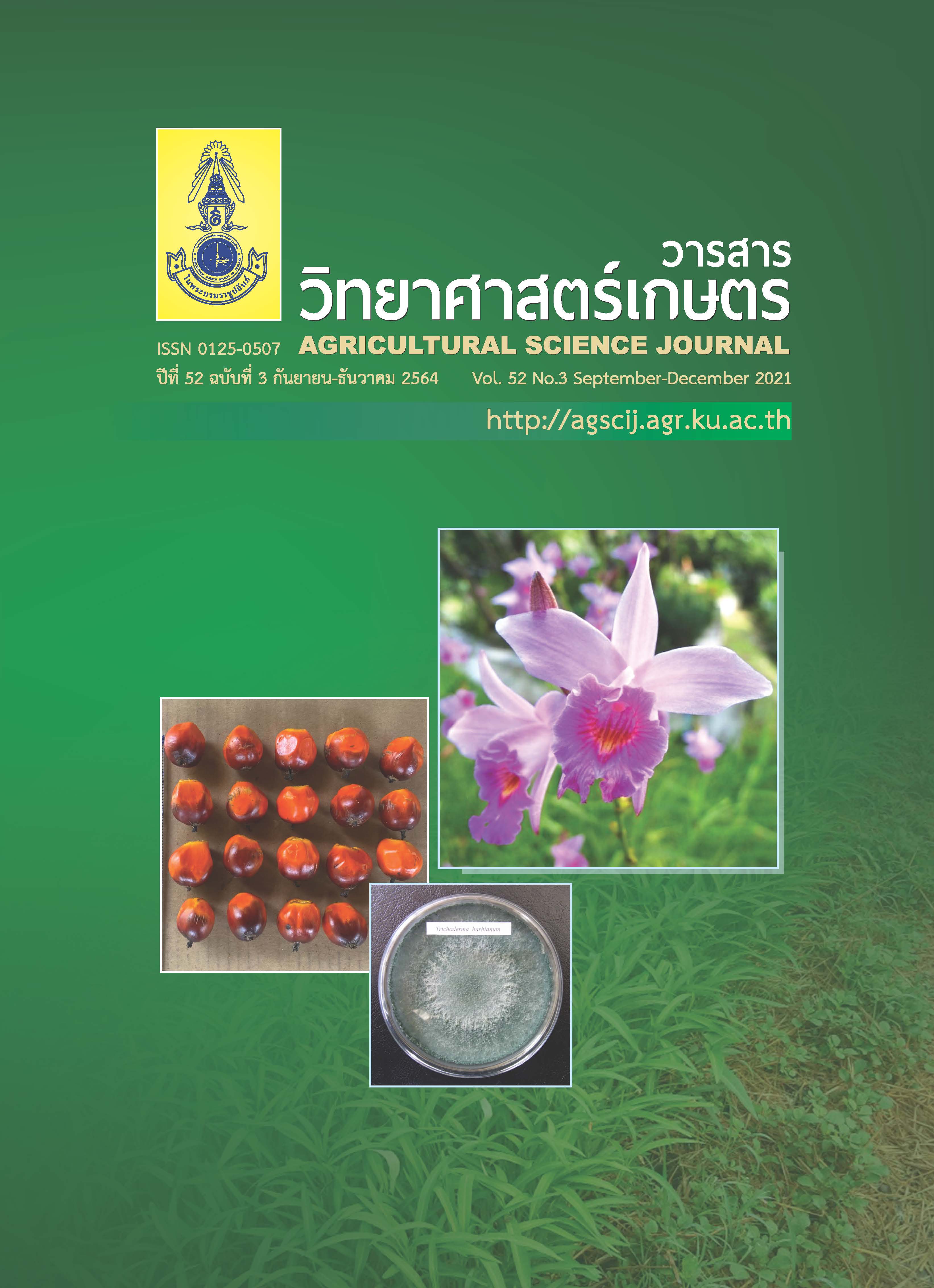ผลการเตรียมพร้อมเมล็ดพันธุ์ด้วยธาตุอาหารและฮอร์โมนพืชต่อการงอกและการเจริญเติบโตของผักบุ้งจีน
Main Article Content
บทคัดย่อ
การเก็บรักษาเมล็ดพันธุ์เป็นระยะเวลานานจะทำให้คุณภาพของเมล็ดพันธุ์ลดลง ซึ่งการเตรียมพร้อมเมล็ดพันธุ์เป็นวิธีการหนึ่งที่ใช้ในการยกระดับคุณภาพเมล็ดพันธุ์ การทดลองนี้จึงมีวัตถุประสงค์เพื่อศึกษาช่วงระยะเวลาการดูดน้ำของเมล็ดพันธุ์ และการเตรียมพร้อมเมล็ดพันธุ์โดยใช้ธาตุอาหารและฮอร์โมนพืชต่อการงอกและการเจริญเติบโตของเมล็ดพันธุ์ผักบุ้งจีน ณ ห้องปฏิบัติการทางเมล็ดพันธุ์ สถานีวิจัยลำตะคอง จังหวัดนครราชสีมา ผลการศึกษาช่วงระยะเวลาการดูดน้ำของเมล็ดพันธุ์ผักบุ้งจีน พบว่า เมล็ดผักบุ้งจีนดูดน้ำอย่างรวดเร็วในชั่วโมงแรก และเริ่มคงที่ในชั่วโมงที่ 2 จากนั้น นำระยะเวลาในการดูดน้ำนี้ไปใช้ในการศึกษาผลของการเตรียมพร้อมเมล็ดพันธุ์พืชโดยใช้ธาตุอาหารพืชและฮอร์โมนพืช วางแผนการทดลองแบบสุ่มสมบูรณ์ (Completely randomized design; CRD) 6 กรรมวิธี คือ ชุดควบคุม (ไม่ผ่านการเตรียมพร้อมเมล็ดพันธุ์) และเตรียมพร้อมเมล็ดพันธุ์โดยแช่เมล็ดในแคลเซียมคลอไรด์ (CaCl2) แมกนีเซียมซัลเฟต (MgSO4) โพแทสเซียมไนเตรต (KNO3) ออกซิน (1-Naphthaleneacetic acid; NAA) และจิบเบอเรลลิน (Gibberellin; GA3) ผลการศึกษาพบว่า การกระตุ้นการงอกเมล็ดพันธุ์ผักบุ้งจีนด้วยกรรมวิธีต่าง ๆ ส่งผลต่อการงอกของเมล็ดพันธุ์อย่างมีนัยสำคัญยิ่งทางสถิติ (P < 0.01) โดยทำให้เมล็ดมีเปอร์เซ็นต์ความงอกและดัชนีการงอกเพิ่มขึ้น เมื่อเปรียบเทียบกับเมล็ดที่ไม่ผ่านการเตรียมพร้อม และเมื่อทดสอบการงอกในโรงเรือนเปิดด้วยการเพาะในกระบะเพาะ เมล็ดที่ผ่านการเตรียมพร้อมด้วยการแช่ใน KNO3 ความเข้มข้น 300 ppm ทำให้เมล็ดมีเปอร์เซ็นต์ความงอก (98.00 ± 0.82 เปอร์เซ็นต์) และดัชนีการงอก (33.00 ± 0.45) ที่สูง และทำให้ต้นกล้าผักบุ้งจีนมีความยาวลำต้น (15.48 ± 0.50 เซนติเมตร) และน้ำหนักสด (7.58 ± 0.70 กรัม) สูงเช่นกัน
Article Details

อนุญาตภายใต้เงื่อนไข Creative Commons Attribution-NonCommercial-NoDerivatives 4.0 International License.
เอกสารอ้างอิง
Ahmad, A. and S. Hayat. 1999. Response of nitrate reductase to substituted IAA in pea seedlings, pp. 252–259. In G.C. Srivastava, K. Singh and M. Pal, eds. Plant Physiology for Sustainable Agriculture. Pointer Publisher, Jaipur, India.
Ahmad, A., S. Hayat, Q. Fariduddin and S. Alvi. 2001. Germination and α-amylase activity in the grains of wheat, treated with chloroindole acetic acids. Seed Technol. 23: 88–91.
Anugoolprasert, O., P. Bunwatthanakul and S. Chakhatrakan. 2015. Effects of high quality organic fertilizer, chemical fertilizer and their combinations on growth and yield of kangkong (Ipomoea aquatic Forsk.). Agric. Technol. J. 23(6)(Suppl.): 970–982. (in Thai)
AOSA (Association of Official Seed Analysts). 1983. Seed Vigor Testing Handbook. Association of Official Seed Analysts, New York, USA. 93 pp.
Bewley, J.D. and M. Black. 1982. Physiology and Biochemistry of Seeds in Relation to Germination. Volume 2: Viability, Dormancy, and Environmental Control. Springer-Verlag Berlin Heidelberg, New York, USA. 375 pp.
Boonyakiat, D. 1996. Plant Physiology. Faculty of Agriculture, Chiang Mai University, Chiang Mai, Thailand. 215 pp. (in Thai)
Bradford, K.J. 1986. Manipulation of seed water relation via osmotic priming to improve germination under stress condition. HortScience. 21(5): 1105–1112.
Bunnag, S. 1999. Introduction to Plant Physiology. Department of Biology, Faculty of Science, Khon Kaen University, Khon Kaen, Thailand. 334 pp. (in Thai)
Cayanan, D.F., M. Dixon, Y. Zheng and J. Llewellyn. 2009. Response of container-grown nursery plants to chlorine used to disinfest irrigation water. HortScience. 44(1): 164–167.
Chanprasert, W. 2010. Seed Physiology. Faculty of Agriculture, Kasetsart University, Bangkok, Thailand. 167 pp. (in Thai)
Chauhan, J.S., Y.K. Tomar, N. Indrakumar Singh, Seema Ali and Debarati. 2009. Effect of growth hormones on seed germination and seedling growth of black gram and horse gram. J. Am. Sci. 5(5): 79–84.
Duangpatra, J. 1986a. Seed Technology. Faculty of Agriculture, Kasetsart University, Bangkok, Thailand. 210 pp. (in Thai)
Duangpatra, J. 1986b. Seed Testing and Analysis. Faculty of Agriculture, Kasetsart University, Bangkok, Thailand. 195 pp. (in Thai)
Gupta, S.M., P. Pandey, A. Grover and Z. Ahmed. 2011. Breaking seed dormancy in Hippophae salicifolia, a high value medicinal plant. Physiol. Mol. Biol. Plants. 17(4): 403–406.
Hentrich, M., C. Böttcher, P. Düchting, Y. Cheng, Y. Zhao, O. Berkowitz, J. Masle, J. Medina and S. Pollmann. 2013. The jasmonic acid signaling pathway is linked to auxin homeostasis through the modulation of YUCCA8 and YUCCA9 gene expression. Plant J. 74(4): 626–637.
Heydecker, W. and P. Coolbear. 1977. Seed treatments for improved performance-survey and attempted prognosis. Seed Sci. Technol. 5: 353–425.
Hirasawa, E. 1989. Auxins induce α-amylase activity in pea cotyledons. Plant Physiol. 91(2): 484–486.
ISTA (International Seed Testing Association). 2016. International Rules for Seed Testing 2016 Edition. International Seed Testing Association, Zurich, Switzerland. 284 pp.
Kaewsorn, P., P. Boonyuen and P. Chulaka. 2014. Preliminary study of physical characteristic and imbibition of some cucurbit seeds. Agricultural Sci. J. 45(2)(Suppl.): 549–552. (in Thai)
Kangsopa, J., B. Mueangthong, P. Jeephet, S. Chantain and P. Thongplew. 2020b. Effect of seed priming with KNO3 and coating on germination, seedling growth and longevity of field corn seeds. J. Agri. Prod. 2(2): 15–30. (in Thai)
Kangsopa, J., T. Siriboon, B. Mueangthong, P. Jeephet and B. Tasour. 2020a. Changes of germination and seedling growth of hybrid sweet corn after osmopriming with potassium nitrate. Khon Kaen Agr. J. 48(Suppl.1): 437–444. (in Thai)
Liphadzi, M.S., M.B. Kirkham and G.M. Paulsen. 2006. Auxin-enhanced root growth for phytoremediation of sewage-sludge amended soil. Environ. Technol. 27(6): 695–704.
Magidin, M., J.K. Pittman, K.D. Hirschi and B. Bartel. 2003. ILR2, a novel gene regulating IAA conjugate sensitivity and metal transport in Arabidopsis thaliana. Plant J. 35: 523–534.
Maneerat, C., P. Rithichai and Y. Jirakiattikul. 2013. Effects of salicylic acid and folic acid priming on germination, vigor and seedling growth of kangkong. Thai Science and Technology Journal 21(6)(Suppl.): 511–519. (in Thai)
Miransari, M. and D.L. Smith. 2014. Plant hormones and seed germination. Environ. Exp. Bot. 99: 110–121.
Osotsapha, Y. 2015. Plant Nutrition. Faculty of Agriculture at Kamphaeng Saen, Kasetsart University, Nakhon Pathom, Thailand. 548 pp. (in Thai).
Piriyawirut, S., S. Amkha, T. Mala and P. Rungcharoenthong. 2015. Effect of calcium silicate fertilizer for improve seed germination and seedling production of melon. Khon Kaen Agr. J. 43(Suppl. 1): 349–353. (in Thai)
Pothikhawet, C., M. Somseang and S. Photchanachai. 2012. Enhancement of seeds quality of four economic crops by priming. Agricultural Sci. J. 43(2)(Suppl.): 397–400. (in Thai)
Rithichai, P. and A. Pipatkornsakul. 2008. Effects of hydropriming treatments on germination and vigor of coriander seeds. Khon Kaen Agr. J. 36: 235–240. (in Thai)
Rivas, M., F.J. Sundstrom and R.L. Edwards. 1984. Germination and crop development of hot pepper after seed priming. HortScience. 19(2): 279–281.
Saikhamwong, N. and B. Siri. 2019. Changes of tomato seeds quality after coating with plant growth regulators and longevity. King Mongkut’s Agricultural Journal. 37(1): 165–178. (in Thai)
Siri, B. 2015. Seed Conditioning and Seed Enhancement. Department of Plant Science and Agricultural Resources, Faculty of Agriculture, Khon Kaen University, Khon Kaen, Thailand. 239 pp. (in Thai)
Theerakulpisut, P. 1997. Plant Physiology. Department of Biology, Faculty of Science, Khon Kaen University, Khon Kaen, Thailand. 366 pp. (in Thai)
Thornalley, P.J. 1990. The glyoxalase system: new developments towards functional characterization of a metabolic pathway fundamental to biological life. Biochem. J. 269(1): 1–11.
Wetchakama, N. and P. Khaengkhan. 2018. Improvement of seed qualities with seed priming techniques. Prawarun Agr. J. 15(1): 17–30.


